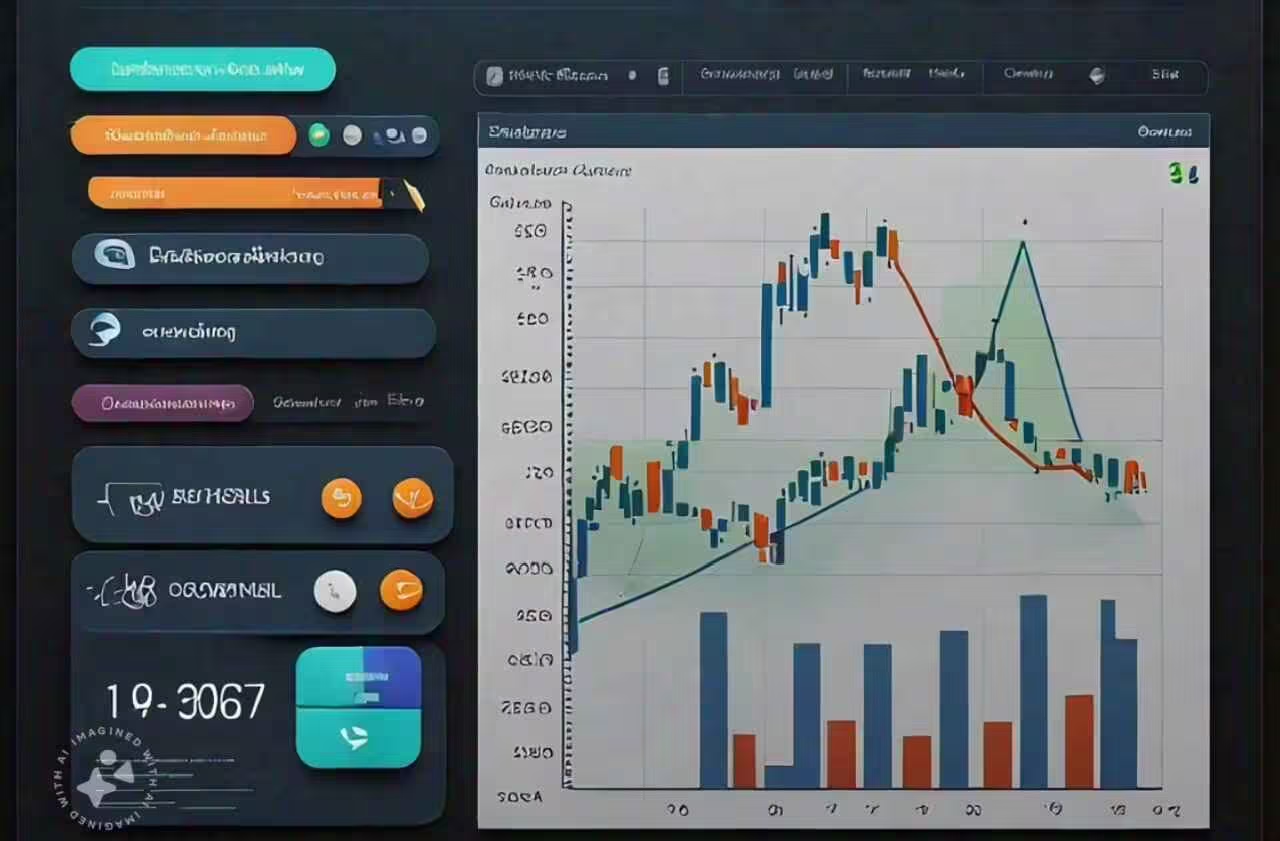Law of Large Numbers

The Law of Large Numbers (LLN) is a fundamental theorem in probability theory and statistics. It describes the result of performing the same experiment a large number of times. This principle is foundational for understanding how probabilities and averages behave when dealing with random events. In this blog post, we will break down the Law of Large Numbers, explain its significance, and explore its applications in various fields like statistics, economics, finance, and even everyday decision-making.
What is the Law of Large Numbers?
The Law of Large Numbers is a statistical principle that states that as the number of trials in a probability experiment increases, the average of the results obtained from these trials will converge towards the expected value. In simpler terms, as you conduct more observations, the sample mean gets closer to the true population mean.
The Law of Large Numbers comes in two primary forms: the Weak Law of Large Numbers (WLLN) and the Strong Law of Large Numbers (SLLN). Both laws assert that under certain conditions, when the number of trials or observations increases indefinitely, the sample average converges to the true average.
Weak Law of Large Numbers
The Weak Law of Large Numbers (WLLN) focuses on probability and convergence. According to the WLLN, as the number of observations increases, the probability that the sample mean will be close to the population mean approaches one. In other words, for a sufficiently large number of trials, the average of the results becomes increasingly likely to approximate the expected value.
Strong Law of Large Numbers
The Strong Law of Large Numbers (SLLN) is slightly more rigorous than the WLLN. It guarantees that as the number of trials goes to infinity, the sample mean almost surely (with probability 1) converges to the population mean. The SLLN essentially says that the average of an infinite number of trials is not just probable but certain to equal the expected value.
The Mathematical Formula
The Law of Large Numbers can be expressed mathematically. Suppose you conduct an experiment multiple times, and X1,X2,X3,…,XnX_1, X_2, X_3, \dots, X_n represent the outcomes of each trial. Each XiX_i is a random variable with an expected value E(X)E(X) and variance σ2\sigma^2. The sample mean after nn trials is given by:
Xˉn=1n∑i=1nXi\bar{X}_n = \frac{1}{n} \sum_{i=1}^{n} X_i
According to the Law of Large Numbers, as n→∞n \to \infty, Xˉn\bar{X}_n converges to E(X)E(X), the expected value:
limn→∞Xˉn=E(X)\lim_{n \to \infty} \bar{X}_n = E(X)
This equation expresses the idea that with enough trials, the sample average Xˉn\bar{X}_n will closely approximate the true population mean.
Importance of the Law of Large Numbers
The Law of Large Numbers is a crucial concept in probability and statistics, and its importance extends to numerous areas. Here’s why this law is significant:
Predictability
The LLN allows for more predictable outcomes when a large number of trials are conducted. For example, in gambling, a casino knows that despite short-term wins and losses, the house edge ensures profitability over a long period due to the Law of Large Numbers.
Accuracy in Estimations
In fields like polling, surveys, and market research, the Law of Large Numbers is fundamental. The more data points collected, the more accurately a pollster or analyst can predict the true population characteristic, such as average income or political preference.
Financial Markets
Investors and traders often rely on the Law of Large Numbers to guide decision-making. In portfolio theory, the larger the sample size of past market data, the better the estimate of future performance. In insurance, for example, companies depend on the Law of Large Numbers to predict risks and set premiums.
Real-Life Examples
Example 1: Coin Flipping
Consider a simple example: flipping a fair coin. The probability of getting heads or tails is 0.5. If you flip the coin just a few times, it’s possible that you might get more heads than tails (or vice versa). However, as you flip the coin hundreds or thousands of times, the proportion of heads and tails will converge to 50% each. This is the Law of Large Numbers in action.
Example 2: Casinos and Gambling
Casinos operate based on the Law of Large Numbers. Games like roulette and blackjack are designed with a small house edge. While individual players may win or lose in the short run, over thousands of plays, the casino’s profit approaches the expected edge, ensuring long-term profitability.
Example 3: Insurance Industry
The Law of Large Numbers is a cornerstone of the insurance industry. Insurance companies pool large numbers of policyholders to predict the likelihood of events like accidents, illnesses, or property damage. Although the occurrence of claims is unpredictable for a single policyholder, the average claim rate becomes stable and predictable across a large group of policyholders, allowing insurers to set premiums appropriately.
Applications of the Law of Large Numbers
Statistics and Sampling
In statistics, the Law of Large Numbers provides a foundation for understanding how random samples behave. It ensures that as the sample size increases, the sample mean becomes a reliable estimate of the population mean. This principle is critical when making inferences from a sample about a population, such as in hypothesis testing and confidence intervals.
Finance and Risk Management
This law is widely used in finance, particularly in portfolio management and risk assessment. When investors diversify their portfolios by holding many different stocks or bonds, they rely on the LLN to mitigate risk. The performance of a well-diversified portfolio will reflect the overall market performance rather than the success or failure of individual investments.
Machine Learning and Data Science
In machine learning and data science, large datasets are used to train models. The Law helps explain why more data generally leads to better model performance. As the dataset size increases, the model’s predictions converge to the true values, reducing overfitting and improving generalization to unseen data.
Sports Analytics
Sports analysts use the Law of Large Numbers to make predictions based on player performance and team statistics. Over a few games, a player’s performance may fluctuate, but over a season or career, the average performance converges to a stable level, allowing for more accurate predictions and assessments.
Economics
Economists often use the Law of Large Numbers when analyzing large datasets, such as national economic indicators or consumer behavior data. By averaging out individual variations, they can draw meaningful conclusions about the overall economy. For example, in predicting unemployment rates, the Law of Large Numbers ensures that the average of a large sample of workers will accurately reflect the true unemployment rate.
Misconceptions About the Law of Large Numbers
Despite its widespread use, the Law of Large Numbers is sometimes misunderstood. Here are a few common misconceptions:
Misconception 1: The Gambler’s Fallacy
The Gambler’s Fallacy is the mistaken belief that past independent events can influence future outcomes. For example, after several consecutive coin flips resulting in heads, one might believe that a tails result is “due.” The Law of Large Numbers does not imply that past outcomes affect future ones. Each coin flip is independent, and the probability remains constant.
Misconception 2: Short-Term Convergence
Some people mistakenly believe that the Law of Large Numbers guarantees convergence in a small number of trials. However, the law only applies to a large number of trials. In the short term, randomness and fluctuations are common, but as the number of trials increases, the averages begin to stabilize.
Misconception 3: Certainty in Small Samples
Another misconception is that the LLN applies to small samples, but this is not the case. Small sample sizes are more prone to randomness, and the sample mean may not reflect the population mean. Large sample sizes are required for the Law of Large Numbers to take effect.
Variations of the Law of Large Numbers
While the Law of Large Numbers is typically applied to averages, there are other variations of the law that apply in different contexts. These variations can be used to explain how different types of random events behave over a large number of occurrences.
Law of Averages
The Law of Averages is a colloquial term that is often confused with the Law of Large Numbers. The Law of Averages suggests that, in the long run, outcomes will tend to balance out. While this is similar to the LLN, the Law of Averages is not a formal statistical law but rather a common way of expressing how people expect randomness to behave.
Law of Large Deviations
The Law of Large Deviations is a more advanced mathematical concept that deals with the probability of significant deviations from the expected value. It is used in fields like statistical physics and telecommunications to predict the likelihood of rare events occurring even in large numbers of trials.
Limitations of the Law of Large Numbers
While the Law of Large Numbers is powerful, it does have limitations. Here are a few factors to consider when applying this law:
Data Quality
If the data used in an experiment or analysis is biased or flawed, the Law may not produce accurate results. For example, if a survey sample is not representative of the population, the sample mean will not converge to the population mean, no matter how large the sample size is.
Non-Independent Events
The Law of Large Number assumes that each
trial is independent. If the events are dependent or correlated, the law may not hold true. For example, in a series of card draws from a deck without replacement, each draw affects the probabilities of subsequent draws, complicating the application of the LLN.
Infinite Trials
The Law of Large Numbers is theoretical, stating that the sample mean will converge to the expected value as the number of trials approaches infinity. In practice, it is impossible to conduct an infinite number of trials. Therefore, while the law provides a useful guideline, real-world applications will always have limitations based on finite sample sizes.
Conclusion
The Law of Large Numbers is a fundamental principle in statistics and probability that underpins much of statistical analysis, risk management, and decision-making in various fields. Understanding the LLN allows statisticians, researchers, and practitioners to make informed predictions based on large datasets, leading to more accurate and reliable conclusions.
As we have seen, the LLN has significant implications across disciplines, from finance and economics to sports analytics and machine learning. While the law has its limitations and common misconceptions, its value in interpreting data and understanding randomness cannot be overstated.
In summary, the Law of Large Numbers teaches us that with enough data, averages can provide a reliable estimate of true values. As we gather more observations, we can expect our results to become increasingly stable and reflective of underlying patterns. Whether flipping coins, analyzing stock prices, or predicting sports outcomes, the Law of Numbers is a crucial tool for making sense of the randomness that permeates our lives.
Frequently Asked Questions
What is the primary difference between the Weak Law of Large Numbers and the Strong Law of Large Numbers?
The primary difference is in the type of convergence. The Weak Law of Large Numbers states that the sample mean converges in probability to the expected value as the number of trials increases, while the Strong Law of Large Numbers states that the sample mean converges almost surely to the expected value, providing a stronger assurance of convergence.
Can the Law of Large Numbers be applied to any type of data?
The Law of Large Numbers applies best to independent and identically distributed (i.i.d.) random variables. It may not hold in cases where data points are dependent on one another or if the data is biased.
How does the Law of Large Numbers relate to real-life decision-making?
The Law of Large Numbers helps in making decisions based on averages derived from large datasets. For example, in business, understanding customer behavior through large surveys allows companies to make informed marketing strategies, knowing that the averages will be stable and reliable.
What are some practical examples of the Law of Large Numbers in action?
Practical examples include casino games, insurance underwriting, polling data analysis, and investment strategies where diversification relies on the LLN for predicting returns based on historical performance.
Is there a limit to how many trials are necessary for the Law of Large Numbers to apply?
While there is no strict limit, a larger sample size generally leads to more reliable results. The convergence is gradual, and more trials tend to reduce the margin of error, resulting in a more accurate approximation of the true mean.
Why is the Law of Large Numbers important in the field of statistics?
The Law of Large Numbers provides a foundation for inferential statistics, allowing statisticians to draw conclusions about populations based on sample data. It ensures that larger samples yield more accurate estimates, which is crucial for research validity.
What should one be cautious about when applying the Law of Large Numbers?
One should be cautious of biases in data collection, the independence of trials, and the implications of finite sample sizes. Misunderstanding these factors can lead to incorrect assumptions and conclusions.
By understanding the Law of Large Numbers, you equip yourself with a powerful tool for interpreting data and making decisions based on statistical principles. Whether in business, science, or daily life, the LLN helps us navigate the complexities of randomness and uncertainty.






One Comment